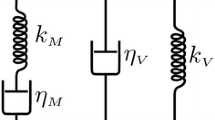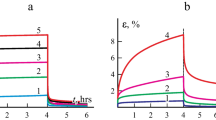Abstract
Test method and data analysis procedures are presented in order to develop a constitutive model which can describe the behavior of visco-elasto-plastic materials due to the external load. A series of creep tests were performed on asphalt concrete. It is shown that the elastic, plastic, viscoelastic and viscoplastic strain components are incorporated and present simultaneously in the total creep strain during the loading process. Elastic and plastic strains of the tested material are linearly proportional to the stress level. The Burger’s model and the Bingham’s model are employed to represent the viscoelastic and viscoplastic response, respectively. Model parameters are extracted from a series of uniaxial compression creep/recovery tests. A good agreement was observed between the verification test result and the prediction from the model.
Similar content being viewed by others
References
Abdulshafi, A.H. and K. Majidzadeh (1984). “Combo viscoelastic-plastic modeling and rutting of asphalt mixtures.”Transp. Res. Rec. 968, Transp. Res. Board, Washington, D.C., pp. 19–31.
Carpenter, S.H., and T.J. Freeman (1986). “Characterizing permanent deformation in asphalt concrete placed over portland cement concrete pavement.”Transp. Res. Rec. 1070, Transp. Res. Board, Washington, D.C., pp. 30–41.
Drescher, A., J.R. Kim, and D.E. Newcomb (1993). “Permanent deformation in asphalt concrete.”J. Mat. Civi. Eng., ASCE, 5, pp. 112–128.
Findley, W., J.S. Lai and K. Onaran (1976). “Creep and relaxation of nonlinear viscoelastic materials.” North-Holland Publishing Company.
Green, A.E., and R.S. Rivlin (1957). “The mechanics of non-linear materials with memory.”Arch. Rat. Mech. Anal., 1, pp. 1–21.
Hills, J.F. (1973). “The creep of asphalt mixes.”J. Inst. Petr., 59, pp. 247–262.
Kim, J.R. (1995). “Viscoelastic analysis of triaxial tests on asphalt concrete.” Ph.D. Thesis, University of Minnesota, USA.
Lai, J.S. and D. Anderson (1974). “Irrecoverable and recoverable nonlinear viscoelastic properties of asphalt concrete.”Transp. Res. Rec. 468, Transp. Res. Board, Washington, D. C., pp. 73–88.
Mahboub, K. and D.N. Little (1988). “Improved asphalt concrete design procedure.” Research Report 474-1F, Texas Transportation Institute.
Moavenzadeh, F. and J. Soussou (1968). “Viscoelastic constitutive equation for sand-asphalt mixtures.”High. Res. Rec. 256, Transp. Res. Board, Washington, D.C., pp. 36–52.
Morris, J., R.C.G. Haas, P. Reily, and E.T. Hignell (1974). “Permanent deformation in asphalt pavements can be predicted.”Proc. Assoc. of Asph. Pav. Techn., 43, Asphalt Paving Technologists, pp. 41–67.
Onat, E.T. (1966). “Description of mechanical behavior of inelastic solids.”Proc. 5th U.S. Nat. Congr. Appl. Mech., pp. 421–434.
Perl, M., J. Uzan, and A. Sides (1983). “Visco-elastic-plastic constitutive law for a bituminous mixture under repeated loading.”Transp. Res. Rec. 911, Transp. Res. Board, Washington, D.C., pp. 20–27.
Pipkin, A.C., and T.G. Rogers (1968). “A non-linear integral representation for viscoelastic behavior.”J. Mech. Phys. Solids, 16, pp. 59–72.
Secor, K.E., and C.L. Monismith (1962). “Viscoelastic properties of asphalt concrete.”High. Res. Board, 41, Washington, D.C., pp. 299–320.
Stafford, R.O. (1969). “On mathematical forms for the material functions in nonlinear viscoelasticity.”J. Mech. Phys. Solids, 17, pp. 339–358.
Suklje, L. (1969). “Rheological aspects of soil mechanics.” Wiley-Interscience.
Van de Loo, P.J. (1978). “The creep test: a key tool in asphalt mix design and in the prediction of pavement rutting.”Proc. Assoc. of Asph. Pav. Techn., 47, Asphalt Paving Technologists, pp. 522–557.
Author information
Authors and Affiliations
Additional information
The manuscript for this paper was submitted for review on April 9, 1997.
Rights and permissions
About this article
Cite this article
Kim, J.R. Laboratory development of a constitutive model for visco-elasto-plastic materials. KSCE J Civ Eng 3, 261–271 (1999). https://doi.org/10.1007/BF02823812
Issue Date:
DOI: https://doi.org/10.1007/BF02823812




